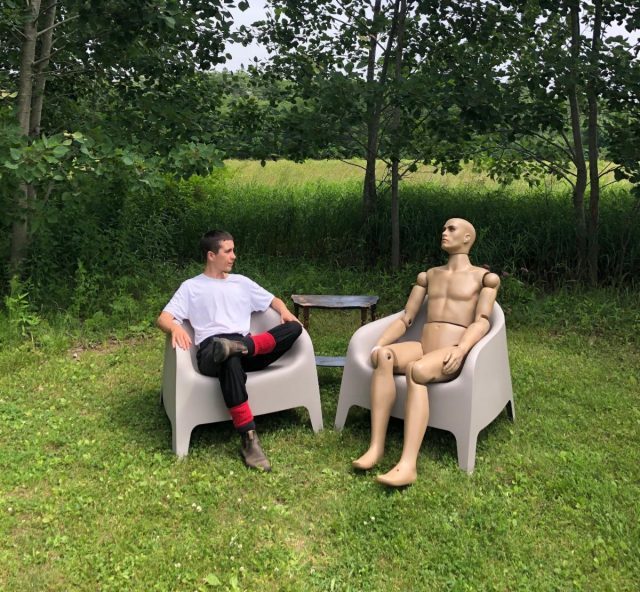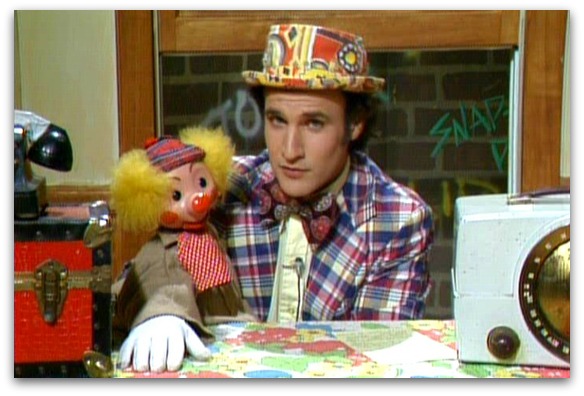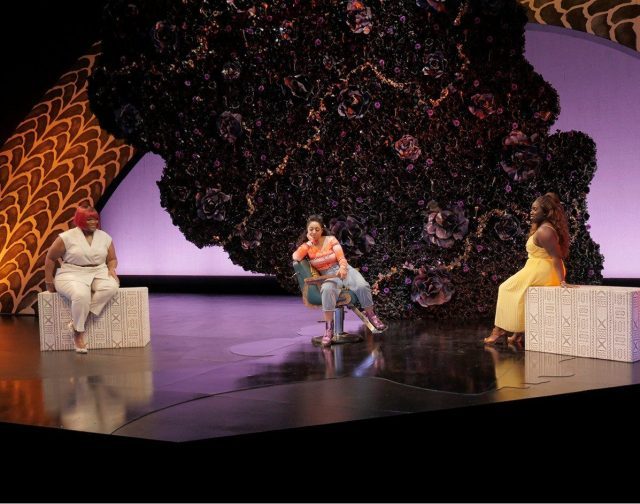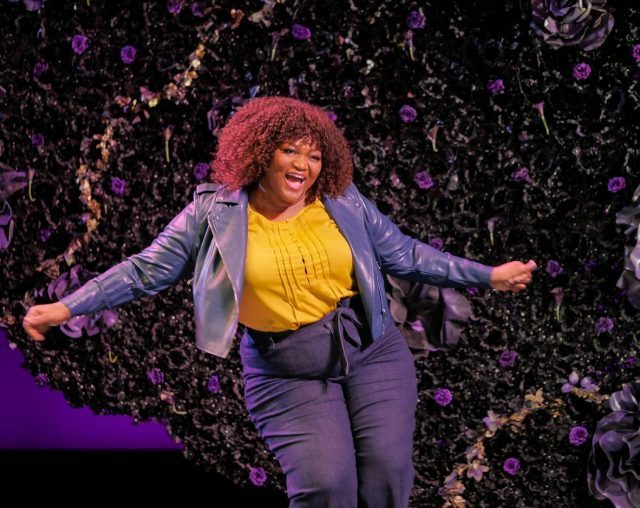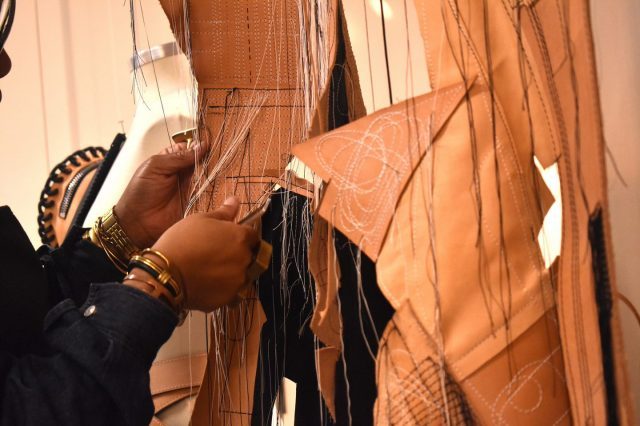
Mia Wright-Ross’s “A Moment to Breathe” exhibition at the Museum of Arts & Design explores sewing as communal healing (photo courtesy MWR Collection, LLC)
Museum of Arts & Design
The Theater at MAD
2 Columbus Circle at 58th St. & Eighth Ave.
Friday – Sunday, March 26 – April 11, $12-$18, eighteen and under free
Activations April 2 & 9, 6:00
212-299-7777
madmuseum.org
Crafting has seen a huge resurgence during the pandemic lockdown. Since March 2020, people around the world have been passing the time by sewing, knitting, crocheting, and taking on other crafting projects (when they’re not baking sourdough bread). So the time is right for Mia Wright-Ross’s new exhibition at the Museum of Arts & Design, “A Moment to Breathe.” Born and raised in Richmond, Virginia, Wright-Ross is the founder and creative director of the Washington Heights–based MWR Collection, a “full-service luxury crafting atelier” that makes handbags, home decor, furniture, and other high-end accessories. The exhibit, which runs Fridays through Sundays through April 11, is the culmination of Wright-Ross’s MAD residency, which included informal Zoom studio visits and online workshops. MAD’s ninth Artist Fellow, Wright-Ross learned her trade at Parsons/the New School of Design, where she is an adjunct professor, at internships and early jobs at such companies as Jimlar, Converse, Talbots, and Calvin Klein, and from such mentors as shoe designer Howard Davis and photographer and professor Bill Gaskins.
The exhibition deals with grief and collective healing in several ways. It is being held in the Theater at MAD and features two monumental leather tapestries, a large sewing machine that Wright-Ross will activate on April 2 and 9 at 6:00 for a limited in-person audience, and a short film made with multidisciplinary artist Akeema-Zane (Sonic Escape Routes: Shall We Fly? or Shall We Resist?) and SCOGÉ builder and designer and media specialist Starnilas Oge. In addition, on April 1 at 7:00, Wright-Ross and Gaskins will participate in the live Online Learning Lab “Artists in Dialogue.” After the opening weekend of the show, Wright-Ross discussed her fascination with leather, sewing, her hometown, the power of artisanship, and more.
twi-ny: You are most well known for your leather creations. What got you into that material?
mia wright-ross: I have always had a love of leather, even as a young child. My mom would collect Coach bags and I remember going to the store to get them repaired and cleaned. I loved the smell of the leather that engulfed me when we walked into the store. That is my first sensory memory with leather. Later in my creative career, I was able to work with leather more intimately when I was introduced to it as a designer by my mentor, Howard Davis. He was my first and only footwear instructor. In his class, I was able to examine the qualities and utility of leather as a material. Since then I have been in love with the dynamic nature of leather as an unforgiving material. Once it is scratched or stitched, you must live with the mark — make it beautiful at all costs.
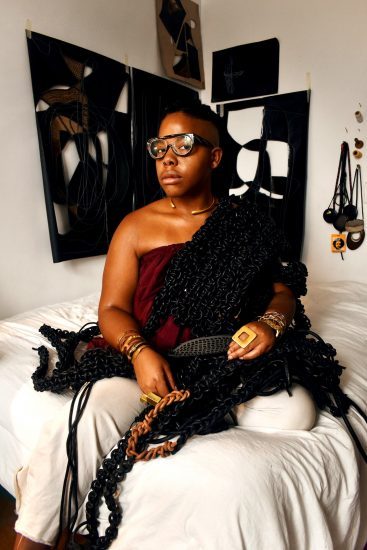
Mia Wright-Ross will be performing live at MAD on April 2 and 9 (photo by Tyler-Andrew Nelson)
twi-ny: Your new MAD exhibit comes at the end of your yearlong residency. What was that experience like? How did the pandemic lockdown affect it?
mwr: Working with MAD has been a delightful experience, especially with all that we have all endured over the past year. The truth is that the residency was initially only six months. I arrived to move into my artist studio within the museum in February 2020, but by mid-March we were told the museum would be closing due to the pandemic. I took a few of my materials and tools and began working in quarantine from my home studio. The MAD Artist Studios department worked with me and extended my fellowship for an additional six months. This allowed me to extend the research and development of my new body of work and also find new ways to connect with the museum’s audience through educational workshops and virtual artist studio visits.
In September 2020, I came back to my studio in the museum with new work in tow. I then realized the amount of work I had created while in quarantine, from the leather sculptures, to the tapestries, and some new works in 2D sketch format. I saw that the incubation of the lockdown was something my creative process was missing. It was the reason I applied for the fellowship in the first place — space to evaluate my reason for being an artisan. I wanted to go inward and find the source of my connection with my work. Amidst all things the pandemic brought — the fear, the grief, and the uprising — personal and collective, I was able to take the time to communicate my feelings and heal through my connection with leather, and I am happy to be able to share that with other artisans.
twi-ny: The show involves sewing, an activity that has flourished during the pandemic, as many people made masks as well as their own clothing. How did the act of sewing come into your life?
mwr: I have been sewing since high school. I was initially taught by a dear family friend, Ms. Gracie. But in 2003, I was accepted to a specialty art program, the Center for the Arts, at my local high school in Richmond. As a little girl, I always wanted to be a fashion designer, so during the summer of my junior–senior high school year, I asked my mother to buy a sewing machine. She purchased a small machine from Walmart and bought me a few Vogue patterns to explore the skill. I instantly fell in love with the process. From there, I took sheets from my great-grandmother’s linen closet, painted textures on them, and began using them to create draped dresses. I had no idea what I was doing but the skill called for me.
twi-ny: On April 2 and 9, you will be onstage, sewing, in front of a limited audience. What do you anticipate for that?
mwr: I want people to engage with the truest parts of themselves when they experience the live performance. The performance adds an additional layer of sensory to the exhibition in that you are able to witness in its most honest and intimate setting, as a space of reverence. I am bringing you into my studio — my worship space. My sewing machine is the altar and I am using my practice to process through my healing as a craftsperson and as a human being.
The film creates an additional layer to the experience as an amalgamation of emotion, visual documentation, making in process, meditation, and memory in sound and visual representation. I hope that the vulnerability of my process allows individuals to assess the areas of themselves that haven’t been allowed to breathe — be it sorrow, love, anger, and anything in between.
twi-ny: How did the film collaboration with Starnilas Oge and Akeema-Zane come about? [ed. note: below film clip courtesy Mia Wright-Ross (@mwrcollection) and her collaborators: Film Design by Starnilas Oge (@scoge2222) and Sound Design by Akeema-Zane (@kissingtherain)]
mwr: They are both dear friends of mine and I knew I wanted to involve my community of artist friends in this work in every way possible. It happened quite naturally. Starnilas has been a close friend in design, and I have always admired his perspective in video/film work. I felt he would bring a level of raw intimacy to the editing process that I couldn’t make possible alone. And Akeema-Zane is truly a sound craftsperson. I’ve known Akeema for a very long time, and we became neighbors over the past few years. I have always admired the ways in which she researches and dissects consciousness through whichever media she is working in. With her exploration in audio design, having her perspective truly enhances the multisensory experience of the exhibition.
twi-ny: On April 1, you will take part in a live conversation with Bill Gaskins. What are some of the things you are looking forward to talking about with him?
mwr: First let me say, Bill Gaskins is my guiding light. He is not only an amazingly talented artist but also my mentor. So, it’s safe to say we will be examining the work in a way that is intimate, philosophical, and examines historical and contemporary context. With Bill, I never know what to expect, which is why he is such a great teacher and artist.
twi-ny: Earlier this month, you were awarded the inaugural Female Design Council grant, which focuses on women of color. What does that mean to you?
mwr: Community is the reason I am able to do the work I do. Without the support of my familial and artist communities, I would not be where I am today. So the award from the Female Design Council means that I am able to continue to do this work and push the bounds of what the design community identifies as an artisan. Design and the luxury industry is a heavily white male–dominated field but women, especially women of color, have consistently contributed to the successes of the design industry from a space of the unseen. From [former slave, seamstress, activist, and author] Elizabeth Hobbs Keckley to [fashion designer] Ann Lowe, Black designers and artisans have always been here and will continue to evolve through our work. I am grateful that the FDC sees this as a vision they want to be a part in supporting designers of color through the support of my studio work.
twi-ny: The health crisis has also led to a severe economic downturn. How has that affected MWR Collection, which specializes in the luxury market?
mwr: Well, the easiest way to respond to this question is that MWR Collection is still here. It has definitely been a learning experience to sustain a small business in a time of economic downturn. But I’ve always sought to maintain MWR Collection as a small, steady, growing business. So when the pandemic began, it meant that I had to reassess my definition of growth — “slow and steady wins the race” was my assessment. Which meant that I could take the time to evaluate our strong suits and ways the brand could be more secure in what we stand for in luxury even during a time of economic instability. I began working with a branding team to strategize on the future of MWR Collection, which is something I didn’t have the time or knowledge to do in the past. Now with the new strategy, I am crowdfunding to support the launch of our new products and maintaining our consistent audience throughout the global luxury market.
twi-ny: Richmond has seen its fair share of controversy recently, primarily involving Monument Ave., and it was also home to BLM protests. Do you still have family there? If so, have you been able to see any of them over the course of the last year?
mwr: Yes, all of my family is still in Richmond. I actually traveled back to VA during the BLM protests last summer. Richmond has always been controversial and will remain this way because of the powerful Black people that push our communities. It was a bit of a shock to see the burned buildings and tags on the statues of Monument Avenue. But this is not a Richmond that is new to me. The ancestral spirit of Richmond has always been rooted in revolutionary Black people. I was happy to see my ancestors’ spirits still thriving in our communities of color and making their presence known as we continue to fight for freedom.
twi-ny: When we come out on the other side of this, what is the first thing you want to do that you’ve been unable to because of Covid-19?
mwr: I don’t like to identify with “the other side of this” when it pertains to the pandemic. This is the world we are living in now, all of it — the protests, the pandemic, the memories, and the grief. We can’t avoid it or history will continue to repeat itself. I hope this exhibition can show people what can be done when we are honest with ourselves, with our experiences, and with each other. Breathe through it all.
